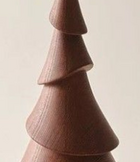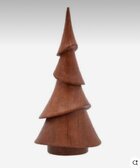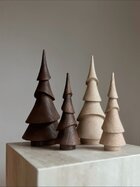-
December 2025 Turning Challenge: Single Tree! (click here for details) -
Congratulations to Bob Henrickson, People's Choice in the November 2025 Turning Challenge (click here for details) -
Congratulations to Guillaume Fontaine for "Old Tea Pot" being selected as Turning of the Week for December 15, 2025 (click here for details) -
Welcome new registering member. Your username must be your real First and Last name (for example: John Doe). "Screen names" and "handles" are not allowed and your registration will be deleted if you don't use your real name. Also, do not use all caps nor all lower case.
You are using an out of date browser. It may not display this or other websites correctly.
You should upgrade or use an alternative browser.
You should upgrade or use an alternative browser.
Can this be turned on a lathe
- Thread starter Dan Pinvidic
- Start date
You could off-center for the whole job, or after initial turning of each tier of the tree. Dead center it, rough round. If you need to, you could start turning each tier dead centered, but its not always necessary. Then you start offsetting back and forth, usually from pre-marked points at the top end, although sometimes both ends, to turn each tier of tree at the angles you want. There are some good videos YT showing a few different processes for making trees like this. Some more extreme than others. You don't necessarily even need an off-center chuck either, it can often just be done between centers.
EDIT:
There appears to be some amount of "flourish" in some of the tiers of that tree. That might take a secondary slight adjustment in the off-centered points you are turning at for that tier after the initial tier shape is done, to get the additional flourish. Or you might need to do that with some carving after the fact. I wonder if the one pictured, may have been done with a CNC, that second from the top has some interesting curvatures to it that I'm not sure are 100% lathe-born.
EDIT:
So my own trees were actually called "leaning trees"...they actually were not strait up as this one is. To get a tree strait like this, but with the angles in the rims of each tier, you would probably have to get pretty inventive with how you chuck. Likely requiring some kind of jamb chuking. You would have to get the rotation along angle you want each tier at, which would mean taking the ends of the blank out of centers, and finding some way to clamp between some kind of jambs, likely on either side. I've never actually done that, but thinking about it, it might be a use case for hot glue. Whatever you do, though, just using a set of offset points at the ends of the blank are likely not going to be enough. The angles of the rim of each tier here, are likely to require the top and bottom to be angled entirely out of either center ranges or even a chuck's range. I think it can definitely be done, but, its likely to require getting rather clever with how you chuck it up for each tier. A key challenge, would be avoiding digging into the lower tier's upper regions...that would require some fairly precise centering of the off-kiltered piece, for each tier...
EDIT:
There appears to be some amount of "flourish" in some of the tiers of that tree. That might take a secondary slight adjustment in the off-centered points you are turning at for that tier after the initial tier shape is done, to get the additional flourish. Or you might need to do that with some carving after the fact. I wonder if the one pictured, may have been done with a CNC, that second from the top has some interesting curvatures to it that I'm not sure are 100% lathe-born.
EDIT:
So my own trees were actually called "leaning trees"...they actually were not strait up as this one is. To get a tree strait like this, but with the angles in the rims of each tier, you would probably have to get pretty inventive with how you chuck. Likely requiring some kind of jamb chuking. You would have to get the rotation along angle you want each tier at, which would mean taking the ends of the blank out of centers, and finding some way to clamp between some kind of jambs, likely on either side. I've never actually done that, but thinking about it, it might be a use case for hot glue. Whatever you do, though, just using a set of offset points at the ends of the blank are likely not going to be enough. The angles of the rim of each tier here, are likely to require the top and bottom to be angled entirely out of either center ranges or even a chuck's range. I think it can definitely be done, but, its likely to require getting rather clever with how you chuck it up for each tier. A key challenge, would be avoiding digging into the lower tier's upper regions...that would require some fairly precise centering of the off-kiltered piece, for each tier...
Last edited:
Thanks Jon for explainging some of the details.....I might give it a shot to see how it goes....
- Joined
- Feb 28, 2021
- Messages
- 1,770
- Likes
- 1,584
- Location
- Roulette, PA
- Website
- www.reallyruralwoodworks.com
I'm pretty sure that's a CNC project unless the guy has hours of carving invested into it, and judging by it seeming to be a "commercial" product , by the photo, I'd say not, so CNC it is...
I don’t think it carved or CNC.
It looks like several cones were turned, the large end cut at an angle, and then stacked on each other. Start at the base and turn a cone. Next level, turn the inside first and fit to the base. Then turn the outside part of the cone. Cut the skirt of the cone. Repeat for as many sections wanted.
Then glue the cones together.
It looks like several cones were turned, the large end cut at an angle, and then stacked on each other. Start at the base and turn a cone. Next level, turn the inside first and fit to the base. Then turn the outside part of the cone. Cut the skirt of the cone. Repeat for as many sections wanted.
Then glue the cones together.
Last edited:
Thanks guys, this input is helpfull. After hearing your thoughts, and looking at the piece more closley, the one odd thing is that little rise in the rim of the second cone from the top.
But hearing your suggestions, I think I will try to turn a basic tree with 4 cones, and then use different offsets for each cone to trim the bottoms. I might be able to get fairly close....AND I might learn something

But hearing your suggestions, I think I will try to turn a basic tree with 4 cones, and then use different offsets for each cone to trim the bottoms. I might be able to get fairly close....AND I might learn something
It didn’t happen without pictures.
Also the bottom of one isn’t flat which makes me think it was cut on a bandsaw and then sanded to get the bevel. Probably a lot easier and safer than a second turning an offset.
You’ll know if the stack concept works after the first cone!
Also the bottom of one isn’t flat which makes me think it was cut on a bandsaw and then sanded to get the bevel. Probably a lot easier and safer than a second turning an offset.
You’ll know if the stack concept works after the first cone!
Last edited:
Thanks guys, this input is helpfull. After hearing your thoughts, and looking at the piece more closley, the one odd thing is that little rise in the rim of the second cone from the top.
But hearing your suggestions, I think I will try to turn a basic tree with 4 cones, and then use different offsets for each cone to trim the bottoms. I might be able to get fairly close....AND I might learn something
Yeah, that extra flourish in the curvature of one down from the top...I am not sure if that could just be purely turned. Its possible it is separate cones cut on a bandsaw stacked on top of each other. There are ways you could do that, turn the cones out of a single piece of wood, connected like a normal christmas tree. You probably want to make the top of each cone pretty narrow, so that when you cut each tier with the desired curvature and then tune them to fit, you get the right thickness at the top of each tier where it will meet the next. Flip it around somehow, so that you can drill a small hole through from the bottom (something that maybe could fit a small dowel). Flip it around again, part each cone off top to bottom. Cut the angles and curvatures with the bandsaw (both the bottom of the upper and top of the lower, so they match) and then connect them all along the same central axis again using that hole and a dowel.
I am not sure that is how the item you pictured was done. The seam between the lower and upper parts at each tier, is just too clean, IMO. If you worked real slow, carefully, meticulously and precisely...I'd say anything could be done, but maybe more work than it would generally be worth?
Thanks guys, this input is helpfull. After hearing your thoughts, and looking at the piece more closley, the one odd thing is that little rise in the rim of the second cone from the top.
But hearing your suggestions, I think I will try to turn a basic tree with 4 cones, and then use different offsets for each cone to trim the bottoms. I might be able to get fairly close....AND I might learn something
I don’t see any evidence of offset turning. Turn a standard 4 cone tree then drill an alignment hole in the center from the bottom up to where the top cut is made. Make the bottom angled cut then finish turning the bottom profile up to the cut. Glue back together make the next cut, rinse and repeat.
- Joined
- Feb 28, 2021
- Messages
- 1,770
- Likes
- 1,584
- Location
- Roulette, PA
- Website
- www.reallyruralwoodworks.com
except if that was done in this case, whoever did it was pretty damn precise in getting his grain lined up perfectly so it appears entirely one piece... Close examination of the piece shows some details that leave me absolutely convinced it is either CNC or an AI image - no way it could be done on a standard lathe alone...I don’t see any evidence of offset turning. Turn a standard 4 cone tree then drill an alignment hole in the center from the bottom up to where the top cut is made. Make the bottom angled cut then finish turning the bottom profile up to the cut. Glue back together make the next cut, rinse and repeat.
Indeed. Any method proposed must account for the perfect grain alignment. I would tend to agree that the alignment, combined with the details of the curves in the profile, is a bit too perfect to have been turned as a single piece.except if that was done in this case, whoever did it was pretty damn precise in getting his grain lined up perfectly so it appears entirely one piece... Close examination of the piece shows some details that leave me absolutely convinced it is either CNC or an AI image - no way it could be done on a standard lathe alone...
So if you took one blank and cut it into smaller blanks, turned, and kept them in order, wouldn’t you get the same alignment of grain when reassembled?
Drilling the alignment hole and using a dowel when glueing back together makes alignment a piece of cake.So if you took one blank and cut it into smaller blanks, turned, and kept them in order, wouldn’t you get the same alignment of grain when reassembled?
True on alignment but not the joinery since the joints aren’t flat so there lies the issue. If you turn 3 round conical tenons that slip into a round conical mortises, you get perfect joints no matter if there is curvature on the bottom skirt. Sorta like stacking ice cream cones.
Maybe this should be a turning challenge?
Maybe this should be a turning challenge?
The joints appear to be flat or nearly so. As long as the curvature of the joint is not severe and the kerf not too wide they should go back together with no problem. Applying a little anathyrosis to the joint surface will give an even better joint.True on alignment but not the joinery since the joints aren’t flat so there lies the issue. If you turn 3 round conical tenons that slip into a round conical mortises, you get perfect joints no matter if there is curvature on the bottom skirt. Sorta like stacking ice cream cones.
Maybe this should be a turning challenge?
So if you took one blank and cut it into smaller blanks, turned, and kept them in order, wouldn’t you get the same alignment of grain when reassembled?
You need to be able to align them axially as well as radially. So, step number one, you would want to...well, something like this:
Code:
1) Round blank
2) Drill alignment hole from base end (the part that would sit on a table) sized to fit a dowel that will run through all segments
a) DO NOT drill all the way through, only enough so that you can align all segments
3) Turn initial cone shapes
a) Might want to over-turn the height of each, to a narrower top than you ultimately intend, to allow for shaping of both the upper and lower segments to each other
4) Part each segment from each other
5) Shape upper segment as desired, then shape the lower segment to fit it (and reduce height till you like the appearance of them fit together) WITH PROPER GRAIN ALIGNMENT
a) I don't know what would be best for this process; bandsaw? sanding drum, belt sander, disc sander?
b) Use alignment dowel to help check and maintain fit
6) Use alignment dowel to align all segments and glue togetherFWIW...if you DON'T care about that curvy flourish underneath the outer rim of each segment. I do think this could be turned. You would have to odd-chuck it, probably with some kind of jamb chuck or something, as I doubt you could hold it in a lathe with the top and bottom within range of a center or a chuck. There might be a few different approaches...depending on the angles of each tier, you might need something like a wood disc, attached to a live center in the tailstock, with holes drilled at different points to support the top of the tree. Then, perhaps something similar, but larger diameter, to hold or otherwise attach the bottom of the tree. If you could attach them securely enough, I think you could potentially turn something similar (but not identical). You likely wouldn't have that curvy flourish, and keeping the top of the lower tier...in tact, I guess, without accidentally turning into it. That would take a lot of care in how you angled and CENTERED the piece along the axis of rotation for each tier. It would definitely be very clever and fringe turning...but I do think its possible.
With those curvy flourishes, though...Brian may be right that its CNC machined.
My daughter has requested a French rolling pin so while I’m making sawdust, I think I’ll give it a go.
I’m not sure what you are calling a curvy flourish. You can only see the bottom of one segment and it appears to be straight across with a slight curve like would be cut on a bandsaw. Those pieces should fit back together without any problem.You need to be able to align them axially as well as radially. So, step number one, you would want to...well, something like this:
Code:1) Round blank 2) Drill alignment hole from base end (the part that would sit on a table) sized to fit a dowel that will run through all segments a) DO NOT drill all the way through, only enough so that you can align all segments 3) Turn initial cone shapes a) Might want to over-turn the height of each, to a narrower top than you ultimately intend, to allow for shaping of both the upper and lower segments to each other 4) Part each segment from each other 5) Shape upper segment as desired, then shape the lower segment to fit it (and reduce height till you like the appearance of them fit together) WITH PROPER GRAIN ALIGNMENT a) I don't know what would be best for this process; bandsaw? sanding drum, belt sander, disc sander? b) Use alignment dowel to help check and maintain fit 6) Use alignment dowel to align all segments and glue together
FWIW...if you DON'T care about that curvy flourish underneath the outer rim of each segment. I do think this could be turned. You would have to odd-chuck it, probably with some kind of jamb chuck or something, as I doubt you could hold it in a lathe with the top and bottom within range of a center or a chuck. There might be a few different approaches...depending on the angles of each tier, you might need something like a wood disc, attached to a live center in the tailstock, with holes drilled at different points to support the top of the tree. Then, perhaps something similar, but larger diameter, to hold or otherwise attach the bottom of the tree. If you could attach them securely enough, I think you could potentially turn something similar (but not identical). You likely wouldn't have that curvy flourish, and keeping the top of the lower tier...in tact, I guess, without accidentally turning into it. That would take a lot of care in how you angled and CENTERED the piece along the axis of rotation for each tier. It would definitely be very clever and fringe turning...but I do think its possible.
With those curvy flourishes, though...Brian may be right that its CNC machined.
Here are some more pictures. By the way, I’m not saying these are not done with a CNC, just that they can be turned fairly easily on a lathe.
View attachment 75157View attachment 75158
It just doesn't look like a strait line cut to me, the whole thing looks curvy. And I don't just mean because its round.
However, that second photo there...I am now honestly wondering if these are injection molded plastic. The second photo, the grain patterns, not only do they look identical, but, they look like grooves, not a different tone of wood...
What if these were not turned at all, but molded?
They do look molded. Hopefully dark and white chocolate!
Sooooo, who’s up to the challenge of making a pretty one from wood!
Sooooo, who’s up to the challenge of making a pretty one from wood!
They do look molded. Hopefully dark and white chocolate!
Sooooo, who’s up to the challenge of making a pretty one from wood!
I am kind of interested in trying. I'm still trying to figure out, what kind of chucking here, might actually work. The angle of the lower rim of each tier. The "outer rim of the branches"...needs to be flat along the rotation axis. Each tier, would need to be angled differently. However, it is more than just angling the piece...its also centering it properly...and that, I think, could be the trickiest part...




